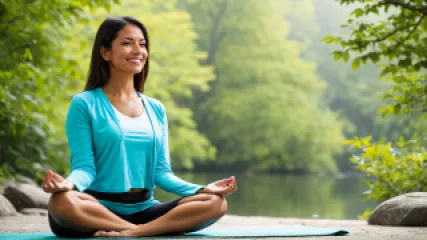Practicing Mindfulness for Anxiety Relief: A Step-by-Step Guide
Introduction:
Anxiety can be a challenging and overwhelming experience, impacting our mental and physical well-being. Fortunately, there are effective techniques to manage anxiety, and one powerful approach is practicing mindfulness. Mindfulness involves intentionally bringing our attention to the present moment without judgment. By cultivating mindfulness, we can develop a greater sense of calm, clarity, and resilience in the face of anxiety.
In this step-by-step guide, we will explore various mindfulness techniques that can help relieve anxiety. Whether you are new to mindfulness or looking to deepen your practice, these exercises can be valuable tools for finding peace amidst the chaos. So let's dive in and discover the transformative power of mindfulness for anxiety relief.
Step 1: Set the Stage
Before diving into mindfulness practices, it's essential to create the right environment that supports your practice. Find a quiet and comfortable space where you can dedicate uninterrupted time to focus on your well-being. Ensure that you won't be disturbed during your mindfulness sessions.
Consider creating a designated area for your mindfulness practice. This could be a corner of your room or a specific cushion or chair that you associate with relaxation and tranquility. Make this space inviting by adding elements that promote a sense of calm, such as candles, plants, or soft lighting.
Step 2: Begin with Breath Awareness
A fundamental aspect of mindfulness is paying attention to our breath. The breath serves as an anchor, grounding us in the present moment. By redirecting our attention to the breath, we can calm the mind and release anxious thoughts.
To start, find a comfortable seated position. Close your eyes gently or maintain a soft gaze. Take a few deep breaths, inhaling through your nose, and exhaling through your mouth. Allow any tension in your body to melt away with each breath.
Shift your focus to your natural breath without trying to change it. Notice the sensation of the breath entering and leaving your body. Observe the rise and fall of your abdomen or the feeling of air passing through your nostrils. Whenever your mind wanders, gently guide your attention back to the breath.
Engage in this breath awareness practice for a few minutes, gradually increasing the duration as you feel more comfortable. Remember, the goal is not to achieve a blank mind but rather to develop a non-judgmental awareness of your present moment experience.
Step 3: Body Scan Meditation
The body scan meditation is a powerful practice to cultivate mindfulness and release tension held within the body. By systematically scanning each part of your body with awareness, you can bring attention to areas of discomfort or stress and invite relaxation.
Find a comfortable lying-down position, ensuring that your body is fully supported. Close your eyes and take a few deep breaths to settle into the practice. Start by directing your attention to your toes. Notice any sensations, warmth, or tingling in this area. Slowly move your attention up through your feet, ankles, calves, and so on, sequentially scanning each part of your body.
As you scan each body part, observe any sensations or emotions that arise without judgment. If you notice tension or discomfort, consciously relax that area by softening the muscles and breathing into it. Continue moving up through your legs, hips, abdomen, chest, arms, neck, and head, paying attention to each region.
Take your time with this practice, spending a few minutes on each body part. Remember to breathe deeply and fully throughout the scan. By the end of the practice, you should feel a sense of relaxation and connection to your body.
Step 4: Cultivate Gratitude
Gratitude is a powerful antidote to anxiety, shifting our focus from negativity to appreciation. By deliberately cultivating gratitude, we can rewire our brains to notice and savor the positive aspects of our lives, reducing anxiety and enhancing overall well-being.
One simple way to practice gratitude is by keeping a gratitude journal. Set aside a few minutes each day to write down three things you are grateful for. They can be big or small, ranging from a beautiful sunrise to a supportive friend or a personal accomplishment.
As you write, allow yourself to fully immerse in the feelings of gratitude. Reflect on why each item on your list is meaningful to you. This exercise trains your mind to seek out positivity and helps counterbalance the anxious thoughts that often dominate our thinking.
In addition to journaling, you can also incorporate gratitude into your daily life by expressing appreciation to others. Take a moment to thank someone who has made a positive impact on your day. It could be a family member, friend, coworker, or even a stranger. By acknowledging and expressing gratitude, you not only uplift others but also cultivate a sense of connection and well-being within yourself.
Step 5: Engage in Virtual Mindfulness Sessions
In today's digital age, we have access to a wide range of virtual resources that can support our mindfulness practice. Virtual therapy for anxiety is one such resource that offers convenience and flexibility while providing professional guidance.
Consider participating in virtual mindfulness sessions led by experienced teachers or therapists. These sessions can be live-streamed or pre-recorded, allowing you to engage in mindfulness practices from the comfort of your own home. Virtual sessions provide structure, accountability, and the opportunity to connect with a community of like-minded individuals.
Several online platforms offer virtual mindfulness sessions, ranging from guided meditations to interactive workshops. Take advantage of these resources and explore different sessions to find what resonates with you. Remember to approach virtual mindfulness sessions with an open mind and be patient with yourself as you navigate this new experience.
Step 6: Incorporate Mindfulness into Daily Activities
Mindfulness is not limited to formal meditation practices; it can be woven into our daily activities. By bringing a mindful presence to routine tasks, we can cultivate a sense of calm and reduce anxiety throughout the day.
Choose one or two activities that you engage in daily, such as brushing your teeth, washing dishes, or taking a shower. Commit to performing these activities mindfully, paying attention to each sensation, movement, and breath. Notice the temperature of the water, the feeling of the toothbrush against your teeth, or the scent of the soap.
When your mind wanders, gently guide your attention back to the present moment. By infusing mindfulness into your daily routine, you develop a deeper appreciation for the simple joys of life and create space for relaxation amidst the busyness.
Conclusion
Mindfulness is a powerful practice for managing anxiety and nurturing overall well-being. By incorporating these step-by-step techniques into your daily life, you can cultivate a greater sense of peace, resilience, and joy. Remember that mindfulness is a journey, and each moment offers an opportunity to come back to the present moment with kindness and curiosity. Embrace the transformative power of mindfulness and embark on a path towards anxiety relief and self-discovery.
Disclaimer: The information in this article is intended for informational purposes only and should not be considered as professional medical or mental health advice. Always consult with a qualified healthcare professional for personalized guidance.






